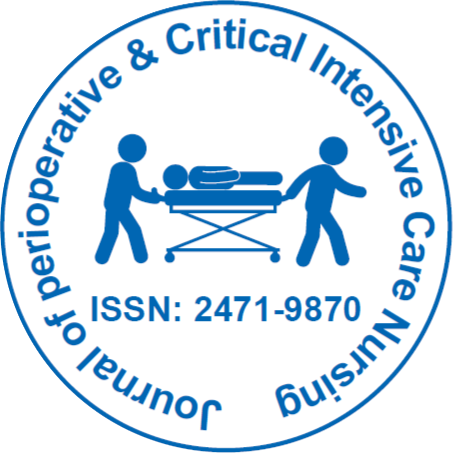
Journal of Perioperative & Critical Intensive Care Nursing
Open Access
ISSN: 2471-9870
+44-77-2385-9429

ISSN: 2471-9870
+44-77-2385-9429
Commentary - (2024)Volume 10, Issue 2
The nurse-patient ratio in Intensive Care Units (ICUs) is a critical determinant of patient care quality and safety. As the demand for intensive care services grows and healthcare systems face staffing challenges, understanding the implications of nurse staffing on patient outcomes becomes increasingly vital. This article discusses about the significance of nurse-patient ratios in ICUs, examines current research findings, discusses challenges, and proposes strategies to optimize staffing for improved patient care. Continued research and evidence-based approaches are essential to further understanding the precise impact of nurse staffing on ICU outcomes and developing customized solutions to enhance care delivery amidst evolving healthcare demands.
Importance of nurse-patient ratio in ICU
Nurse staffing levels directly influence the quality of care and patient outcomes in ICUs. Higher nurse-patient ratios have been associated with reduced mortality rates, decreased rates of healthcare-associated infections, and shorter hospital stays. Adequate staffing enables nurses to provide timely interventions, monitor patients closely, and respond promptly to changes in their condition, thereby enhancing overall care effectiveness and patient safety. Nurse staffing levels directly influence the quality of care and patient outcomes in ICUs. Higher nurse-patient ratios have been associated with reduced mortality rates, decreased rates of healthcare-associated infections, and shorter hospital stays. Adequate staffing enables nurses to provide timely interventions, monitor patients closely, and respond promptly to changes in their condition, thereby enhancing overall care effectiveness and patient safety.
Current research and findings
In critical care settings, maintaining appropriate nurse-patient ratios is a important factor influencing patient outcomes and overall safety.
Mortality rates: Studies indicate that lower nurse-patient ratios are associated with lower mortality rates among critically ill patients. For example, a study found that each additional patient per nurse in the ICU was associated with a 7% increase in the likelihood of mortality.
Complications and infections: Adequate nurse staffing has been linked to decreased rates of complications such as ventilator-associated pneumonia, catheter-related bloodstream infections, and pressure ulcers.
Patient safety and quality indicators: Hospitals with better nurse staffing ratios tend to perform better on patient safety indicators, including medication errors, falls, and readmissions.
Challenges and considerations
Understanding these challenges is imporatant for developing effective strategies.
Staffing shortages: Many healthcare facilities face challenges in recruiting and retaining qualified critical care nurses, leading to suboptimal nurse-patient ratios.
Financial constraints: Budgetary constraints and financial pressures often limit the ability of healthcare institutions to hire additional nursing staff.
Workload and burnout: High nurse-patient ratios contribute to increased nurse workload, which can lead to burnout, job dissatisfaction, and compromised patient care.
Variability in standards: There is variability in nurse staffing standards across different regions and healthcare settings, making it challenging to establish universally applicable guidelines.
Strategies for optimizing nurse-patient ratio
Strategies for optimizing nurse-patient ratio includes:
Policy and regulation: Implementing regulatory standards and guidelines for nurse staffing ratios specific to critical care settings can help ensure consistency and quality of care delivery.
Workforce planning: Proactive workforce planning, including recruitment, retention strategies, and professional development opportunities, can help mitigate staffing shortages and improve nurse-patient ratios.
Technology and workflow optimization: Leveraging technology, such as nurse call systems, Electronic Health Records (EHRs), and automated monitoring tools, can streamline workflow and enhance efficiency, allowing nurses to focus more on direct patient care.
Interprofessional collaboration: Promoting collaboration among healthcare teams, including physicians, nurses, respiratory therapists, and pharmacists, encourage a team-based approach to patient care and supports effective resource utilization.
The nurse-patient ratio in ICU settings plays a pivotal role in determining patient outcomes and care quality. Adequate staffing levels enable nurses to deliver timely, safe, and effective care to critically ill patients, reducing mortality rates and improving overall outcomes. As healthcare systems continue to evolve, prioritizing nurse staffing optimization through evidence-based practices, policy initiatives, and interdisciplinary collaboration will be essential in ensuring high-quality care in ICUs.
Citation: Granvil B (2024) Nurse-Patient Ratios in Critical Care: Balancing Care Quality and Patient Outcomes. J Perioper Crit Intensive Care Nurs. 10:255.
Received: 21-May-2024, Manuscript No. JPCIC-24-32842; Editor assigned: 23-May-2024, Pre QC No. JPCIC-24-32842 (PQ); Reviewed: 06-Jun-2024, QC No. JPCIC-24-32842; Revised: 13-Jun-2024, Manuscript No. JPCIC-24-32842 (R); Published: 20-Jun-2024 , DOI: 10.35248/2471-9870.24.10.255
Copyright: © 2024 Granvil B. This is an open-access article distributed under the terms of the Creative Commons Attribution License, which permits unrestricted use, distribution, and reproduction in any medium, provided the original author and source are credited.